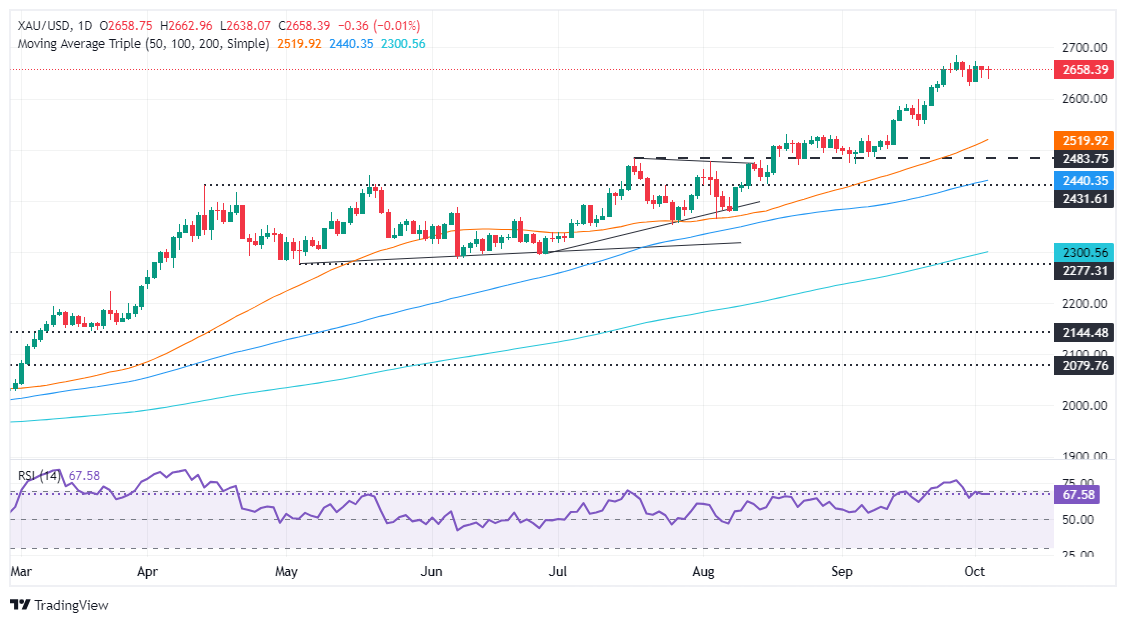Gold price rebounds to $2,650 as Middle East conflict escalates
- Gold rises from $2,638 to $2,659, fueled by escalating tension between Israel and Iran and increasing US Treasury yields.
- US labor market data softens; however, ISM Services PMI reflects better business activity in September.
- US Dollar Index (DXY) up 0.35%, 10-year Treasury yields climb to 3.84%, tempering market expectations for big November rate cut.
Gold price recovers in the mid-North American session on Thursday after hitting a daily low of $2,638. The golden metal rose on rising fears over the Israel–Iran conflict along with a stronger US Dollar. In addition, bets that the Federal Reserve (Fed) will ease policy aggressively faded and boosted US yields. The XAU/USD trades at $2,659.
Wall Street trades with losses amid rising geopolitical risk. The market mood remains downbeat as Israel advanced its military into Lebanon despite Iran’s significant missile attack on Tuesday. Meanwhile, US President Joe Biden commented publicly that he discussed attacking Iranian oil facilities with Israeli officials. After the headline, bullion prices rose toward $2,650 and above.
Earlier, US data revealed that the labor market continued to soften. The US Department of Labor revealed that the number of people filing for unemployment benefits rose above estimates. Last but not least, the Institute for Supply Management (ISM) revealed that business activity, measured by the ISM Services PMI, improved in September compared to August’s number.
Other data showed that Factory Orders for August contracted, while traders eye the release of the latest US jobs report on Friday, which is projected to spur volatility in the financial markets.
Meanwhile, Fed officials have crossed the newswires. The Atlanta Fed’s Raphael Bostic stated that the natural employment rate has shifted, and it could be lower. Chicago Fed President Austan Goolsbee said the latest inflation numbers are at the Fed’s target, while the labor market is at full employment.
Regarding lowering rates by 50 or 25 basis points, Goolsbee said it is not as important as getting rates down over the next 12 months to get to neutral.
US Treasury yields continued to rise as traders trimmed their odds for a 50 bps cut in November. The US 10-year Treasury note yields 3.84%, up five basis points. At the same time, the US Dollar Index (DXY), which tracks the buck’s performance against a basket of six peers, gains 0.35% to 101.95.
Daily digest market movers: Gold prices maintain gains as US data hints further easing
- US Initial Jobless Claims for the week ending September 28 rose from 219K to 225K, exceeding estimates of 220K.
- The ISM Services PMI for September expanded from 51.5 to 54.9, while Factory Orders for August contracted by -0.2%, missing the estimate of 0% and down from the previous month's 4.9% increase.
- On Friday, Nonfarm Payrolls are expected to show that the economy added 140K jobs in September, slightly less than the 142K jobs created in August, with the unemployment rate forecast to remain unchanged.
- Market participants have placed the odds of a 25 bps rate cut at 66.7%. According to the CME FedWatch Tool, the chances of a larger 50 bps cut have decreased to 33.3%.
XAU/USD technical analysis: Gold price hovers near $2,650-60
The Gold price uptrend is intact, although registered losses see it edging below $2,650. The Relative Strength Index (RSI) shows momentum remains bullish despite turning flat during the last two trading days.
With that said, XAU/USD might trade within familiar levels. If XAU/USD slides underneath $2,650, this would pave the way for further downside, exposing the September 30 daily low of $2,624, followed by the September 18 peak at $2,600. A breach of those levels and the 50-day Simple Moving Average (SMA) would be up next at $2,519.
On further strength, if it clears the all-time high of $2,685, it could extend its gains to $2,700.

Gold FAQs
Gold has played a key role in human’s history as it has been widely used as a store of value and medium of exchange. Currently, apart from its shine and usage for jewelry, the precious metal is widely seen as a safe-haven asset, meaning that it is considered a good investment during turbulent times. Gold is also widely seen as a hedge against inflation and against depreciating currencies as it doesn’t rely on any specific issuer or government.
Central banks are the biggest Gold holders. In their aim to support their currencies in turbulent times, central banks tend to diversify their reserves and buy Gold to improve the perceived strength of the economy and the currency. High Gold reserves can be a source of trust for a country’s solvency. Central banks added 1,136 tonnes of Gold worth around $70 billion to their reserves in 2022, according to data from the World Gold Council. This is the highest yearly purchase since records began. Central banks from emerging economies such as China, India and Turkey are quickly increasing their Gold reserves.
Gold has an inverse correlation with the US Dollar and US Treasuries, which are both major reserve and safe-haven assets. When the Dollar depreciates, Gold tends to rise, enabling investors and central banks to diversify their assets in turbulent times. Gold is also inversely correlated with risk assets. A rally in the stock market tends to weaken Gold price, while sell-offs in riskier markets tend to favor the precious metal.
The price can move due to a wide range of factors. Geopolitical instability or fears of a deep recession can quickly make Gold price escalate due to its safe-haven status. As a yield-less asset, Gold tends to rise with lower interest rates, while higher cost of money usually weighs down on the yellow metal. Still, most moves depend on how the US Dollar (USD) behaves as the asset is priced in dollars (XAU/USD). A strong Dollar tends to keep the price of Gold controlled, whereas a weaker Dollar is likely to push Gold prices up.

